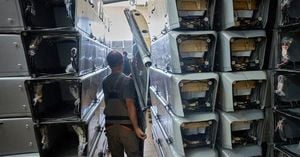Singapore Airlines is making waves with its latest investment, signaling its intent to redefine luxury travel with significant upgrades to its business class. With ambitions to transform the passenger experience, the airline has committed to spending S$1.1 billion on new cabin products across its fleet of 41 Airbus A350-900 aircraft. This extensive overhaul is not just about flashy new seats; it aims to bolster the airline’s reputation for excellence, catering to the desires of the modern traveler.
The centerpiece of this multi-year upgrading project is the introduction of doors on its business class seats. This feature is set to change the game for travelers who cherish privacy and comfort during their flights. According to aviation insiders, the demand for door-equipped cabins has surged globally, prompting airlines to adopt this design for their high-end travel class. Singapore Airlines hopes to attract more premium customers who are seeking those VIP touches, making their long-haul journeys more plush.
Indeed, the airline has announced plans to incorporate these door-equipped business class seats not only on the A350-900s but also on their future Boeing 777-9 aircraft. Slated to take to the skies by the second quarter of 2026, the first retrofitted A350-900 will launch as part of this ambitious timetable, concluding with the completion of the entire retrofitting program by the end of 2030. This timeline shows SIA is serious about enhancing its offerings at speed.
Alongside these upgrades, the airline will also refresh its Economy and Premium Economy cabins, ensuring all passengers will experience notable improvements. The standard of the KrisWorld in-flight entertainment system will rise as well, boasting greater personalization and expanded options for leisure and comfort. The retrofit will be undertaken by SIA Engineering Co Ltd, ensuring high-quality standards and cutting-edge technology are employed.
But how does this investment impact Singapore Airlines' standing in the ever-competitive airline industry? Financial markets have been closely observing these initiatives, and analysts are assessing the potential effects on the airline's stock performance. Post-pandemic recovery has shown signs of robustness for aviation, yet the competitive atmosphere remains fierce. Despite the capacity for strong demand, including Singapore Airlines’ previous profit warnings caused by rising costs and competitive pressure, investors are cautiously optimistic about this strategy.
Earlier reports indicated the airline’s financial results faced pressures from increased operational costs and stiff competition, as highlighted recently as SIA announced its earnings. Following a dip caused by various sectors expressing concerns over market recovery, Singapore Airlines’ latest announcements signify its long-term strategy to regain market share through superior customer experiences. Predictably, the airline emphasized attracting affluent travelers who might otherwise turn to competitors for longer flights.
Just recently, demand for travel surged alongside significant profit projections—an encouraging sign for stockholders. Awareness of potential industry tensions, like inflation and geopolitical uncertainties, calls for airlines, particularly those like SIA, to adapt rapidly to customer desires and changing market dynamics.
So, how does the market view this move by Singapore Airlines? Experts argue these cabin upgrades should positively affect its stock. The company's stocks are likely to benefit from what is perceived as necessary evolution within luxury travel sectors, especially following SIA’s historic lows caused by pandemic-related disruptions. Investors are now witnessing signs of growth as the world seeks to return to travel.
Particularly noteworthy is how Singapore Airlines previously faced tough competition from alternative carriers offering similar luxury experiences yet with more updated facilities. Other international airlines have similarly embraced the trend of incorporating private spaces with doors on premium classes, and SIA’s delayed entry risks losing clientele. Nevertheless, analysts are betting on SIA’s strategic expansion to mount challenges toward rivals as they embrace change.
Further complementing these upgrades, potential investors are keeping tabs on how this movement will intertwine with the larger aviation ecosystem, representing either opportunity or missed chances. By aiming for the affluent segment of passengers, Singapore Airlines signals its awareness of shifting consumer preferences post-COVID-19.
Travelers have expressed mixed feelings on airline offerings and comfort, and studies reveal many now prioritize privacy over amenities. Many frequenters who once tolerated lower privacy standards are flocking toward airlines addressing these demands. Notably, SIA expressed attentiveness to this nuance, with CEO Goh Choon Phong declaring the transition was inspired by customers' changing preferences and expectations.
Despite some skepticism surrounding the airline's capacity to balance luxury with operational excellence, Singapore Airlines seems intent on ensuring its offerings remain as desirable as ever. The addition of door-equipped seats is merely one aspect of enhancing the overall travel experience aimed at differentiators like convenience and exclusivity.
While the speculation and anticipation continue, it’s clear these aspirations by Singapore Airlines reflect more than mere profit motivations; they symbolize the airline's commitment to remain at the forefront of luxury air travel amid uncertainties threatening entire industries.
With time, the market's focus will sharpen to assess how well SIA can deliver on its promise. The conclusions drawn from this venture—whether it emerges as boon or bane for stockholders—remain closely watched as the new airline features begin to materialize. So, will these high-stakes decisions transform SIA’s market rapport? We will have to see as the rest of this year shapes up with gradual changes driven by consumer desires.
Board meetings, analysts’ evaluations, and consumer feedback will spill onto the runway as Singapore Airlines readies itself to face competitors head-on. Amid the clamor of changes advancing both within the industry and globally, SIA’s recent investments embody its determination to maintain relevance, recognizing adaptation is the core need to keep up with the desires of traveling elites. These moves reinforce part of SIA’s larger story: one of resilience, strategy, and commitment to providing the best for its innumerable clientele.



